 A while ago now I was fortunate enough to preview an upcoming portable amplifier from Aune, the company that brought us the excellent and affordable T1 tube DAC / amp. My very brief time with the pre-production B1 portable amplifier suggested a promising product to come. Some of the edges were a little rough on the fingers, but the look and sound quality were undeniably good. It should come as no surprise that I was thrilled when offered the chance to review a production unit courtesy of the good people Aune.
A while ago now I was fortunate enough to preview an upcoming portable amplifier from Aune, the company that brought us the excellent and affordable T1 tube DAC / amp. My very brief time with the pre-production B1 portable amplifier suggested a promising product to come. Some of the edges were a little rough on the fingers, but the look and sound quality were undeniably good. It should come as no surprise that I was thrilled when offered the chance to review a production unit courtesy of the good people Aune.
I received a free Aune B1 for this review and may be given it for free or may be able to purchase it at a reduced price. Either way, the chance to get things for free doesn’t influence my reviews – if it’s no good, I wouldn’t want it anyway and if it’s good, I’ll gladly say that regardless of the possible gain.
Overview
Based on the products thus far (like the S16, T1, and M1), Aune seem focussed on making affordable products with high performance. Sometimes that works extremely well like the T1 DAC, and other times it backfires a bit like the S16 with its slightly sub-par amplifier stage and M1 with its high output impedance and WAV-only design. Both of the misses have shown outstanding potential and the hit (T1) was a real hit, so where will the B1 be placed in history?
At around $250 (AUD) it’s priced in the upper range of affordable portable headphone amps amongst some stiff competition so it’s not necessarily trying to undercut the competition in price and that means it has to outperform them somehow to be really appealing. Let’s see what it’s packing to help with that challenge.
Specifications
- Up to 10 hours playback
- Suitable headphone impedance: 16-300 ohm
- Size: 65 x 110 x 18 mm
- Weight: 230g
- THD: < 0.0008% @ 1kHz
- SNR: > 124dBA
- Frequency response: +/- 0.15dB between 10 Hz – 20,000 Hz
- Crosstalk: < 110dB @ 1kHz
- Power (class A mode): 25mW/16ohm, 500mW/32ohm, 100mW/300ohm
So, on paper the B1 packs plenty of solid specs including low distortion (THD), good channel separation (crosstalk), and decent power. Let’s divert our attention from the specs and the sound to the look and feel of the amp and then we’ll circle back around to talk about the all important sound quality.
Design & Functionality
Size & Weight
The B1 is designed with the fairly typical footprint of most portable amps and that’s a good thing because it will stack well with the many and varied DAPs on the market. That said, it’s a bit bigger and heavier than some of the alternatives. For example, compared to FiiO’s E12 family (E12, E12DIY, and E12A), the B1 has the same chassis width and length, but is about 4mm thicker. It also weighs about 70g more which doesn’t sound like much, but for some people it can start to add up if you’ve got a heavier DAP.
Knobs and Switches
 The B1 is concisely laid out with all switches up one side (power, gain and mode), input, output and volume on one end, a micro USB socket for charging at the other end, and a battery level button on the remaining side. The result is elegant simplicity in terms of the B1’s appearance.
The B1 is concisely laid out with all switches up one side (power, gain and mode), input, output and volume on one end, a micro USB socket for charging at the other end, and a battery level button on the remaining side. The result is elegant simplicity in terms of the B1’s appearance.
The battery level button triggers a simple system of LED flashes to show battery level from 1 flash (charging needed) to 5 flashes (battery full). Just like the overall design, this approach is simple and elegant.
There’s not much to say about the volume knob other than it is an interesting flanged shape, but is easy to hold and turn. It appears to be plastic, but it doesn’t look out-of-place or tacky on the black B1. I’m not sure how the aluminium design fairs with the volume knob.
The inputs are well spaced and slightly recessed with an attractive inward curve from the surrounding metal housing. I was worried that the slight recess might play havoc with some plugs, but have had no problems with the connectors that are most prone to these problems so I don’t think that design choice will have any negative impacts and it looks really nice so I’m glad they did it.
On the action side of the amp are the three most interesting switches. The switches are all made of plastic, but that’s a good thing I believe. The pre-production B1 I played with had aluminium switches and they felt rough to touch because of the slightly sharp edges caused by the machining. It’s possible that Aune could have made smoother aluminium switches for this final production version of the B1, but I’m quite happy with the black plastic. It looks and feels like good quality plastic and is a much smoother and more comfortable user experience than the pre-production version.
The Mode Switch
The mode switch is labelled “Class A” because it changes the current output of the amplifier by changing to A-class operation. I don’t claim to be an electronics expert so I’m not going to attempt to explain A-class operation in detail, but suffice to say that the reasoning behind A-class operation is that you can sacrifice power efficiency (i.e. battery life) to reap benefits in sound quality and that’s what this switch is about.
Aune clearly instruct users to always switch the amplifier off prior to changing modes so direct comparison of the differences in sound are hard to complete without 2 amps side-by-side, but my rapid switching (power off, wait for the click of the relays, change mode, power on) between modes resulted in some subtle differences to sound that were mostly headphone dependent. Some cans prefer A Class while others prefer the normal mode from the B1 it seems. As you’ll read later, I’m a fan of this switch and you might be too. It’s not just a gimmick.
Aesthetics & Finish
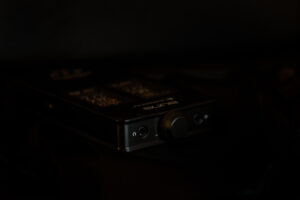 The look and feel of the B1 are both top-notch. The body of the version sent to me is black anodised aluminium rather than the natural aluminium I previewed a while ago. On one face are two windows showing the B1’s heart – it’s discrete amplification circuitry. On the other face are two full-length inserts of black leather (or at least faux leather). Unlike the pre-production unit, the edges of the aluminium sit flush with the leather inserts and make the amplifier smooth and enjoyable to hold. The leather inserts make a really nice touch on the black model and add to the sense that the B1 is a classy and elegant amplifier.
The look and feel of the B1 are both top-notch. The body of the version sent to me is black anodised aluminium rather than the natural aluminium I previewed a while ago. On one face are two windows showing the B1’s heart – it’s discrete amplification circuitry. On the other face are two full-length inserts of black leather (or at least faux leather). Unlike the pre-production unit, the edges of the aluminium sit flush with the leather inserts and make the amplifier smooth and enjoyable to hold. The leather inserts make a really nice touch on the black model and add to the sense that the B1 is a classy and elegant amplifier.
 Back to those two windows on the other side. Other than allowing a glimpse into the B1’s heart, the windows also allow the light of two green LEDs to shine through when the amp is powered up. There’s also a power indicated LED (also green) above the power switch so I assume that the in-window LEDs are more for aesthetics than function and they’re fine. It might have been a nice touch to hide them somewhere so that only their gentle glow could be seen, creating an ethereal light as though the light were emanating from the B1’s soul, but there may be reasons why such fanciful frills were avoided. As it stands the lights are fine. Unnecessary perhaps, but fine and as I think about it, a window with no light would have seemed so boring. At least the LEDs mean that you feel like something happens inside the visible circuit when you throw the switch.
Back to those two windows on the other side. Other than allowing a glimpse into the B1’s heart, the windows also allow the light of two green LEDs to shine through when the amp is powered up. There’s also a power indicated LED (also green) above the power switch so I assume that the in-window LEDs are more for aesthetics than function and they’re fine. It might have been a nice touch to hide them somewhere so that only their gentle glow could be seen, creating an ethereal light as though the light were emanating from the B1’s soul, but there may be reasons why such fanciful frills were avoided. As it stands the lights are fine. Unnecessary perhaps, but fine and as I think about it, a window with no light would have seemed so boring. At least the LEDs mean that you feel like something happens inside the visible circuit when you throw the switch.
Sound
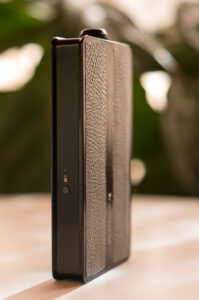 The B1 has a sound that I would describe as clean, crisp and musical with an outstanding sense of space, texture and nuance, but it requires much more explanation than that. With the inclusion of a switch that changes its operation from a normal mode to an “A Class” mode, the B1 can change how it sounds depending on the ‘phones you’re using. Based on headphones I’ve tried I’d suggest that the output impedance of the B1 might be high enough to be incompatible with lower impedance loads and particularly multi-balanced-armature IEMs. Using the B1 with the Noble K10s results in a thick and lush sound that takes the best features of the K10s and pushes them way too far. There are also channel imbalance issues because the volume level is way too high with sensitive IEMs. This is a headphone amp, not an earphone amp (with the possible exception of high impedance IEMs and earbuds).
The B1 has a sound that I would describe as clean, crisp and musical with an outstanding sense of space, texture and nuance, but it requires much more explanation than that. With the inclusion of a switch that changes its operation from a normal mode to an “A Class” mode, the B1 can change how it sounds depending on the ‘phones you’re using. Based on headphones I’ve tried I’d suggest that the output impedance of the B1 might be high enough to be incompatible with lower impedance loads and particularly multi-balanced-armature IEMs. Using the B1 with the Noble K10s results in a thick and lush sound that takes the best features of the K10s and pushes them way too far. There are also channel imbalance issues because the volume level is way too high with sensitive IEMs. This is a headphone amp, not an earphone amp (with the possible exception of high impedance IEMs and earbuds).
Importantly though, shifting from the K10s to the Audeze LCD 2s completely changed my experience. Gone is the additional warmth caused by the K10 mismatch and in its place is a clarity and transparency that sounds like a different amplifier. This is all with the mode switch in the normal position too so hold tight if you want to know what happens when that interesting switch gets flicked.
Jumping now from the rich and warm LCD 2s to the leaner HD800s I hear exactly what I thought was happening – the B1 isn’t producing the full bass presence or impact when running tougher loads. The LCDs and HD800s are tough in different ways – the HD800s present higher resistance and the LCDs present lower sensitivity – both seem to result in the same outcome when the “A Class” switch is off.
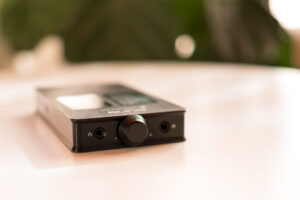 Next, I powered-down the B1 to switch from normal operation to A Class operation in order to see if the extra current fixed the problem…
Next, I powered-down the B1 to switch from normal operation to A Class operation in order to see if the extra current fixed the problem…
So, did it?
Yes… it’s slight, but there’s definitely a change. To my ears the sound in A Class mode has a greater sense of warmth and body compared to the normal mode sound when driving tougher headphones. One thing I definitely notice is that the normal mode sounds slightly disembodied and ethereal with the HD800s and LCDs whereas the A Class mode seems to bring the sound back into focus and creates a better sense of body. It still sounds a touch lean with the HD800s, but I am a fan of tube amps with the HD800s because they can tend towards the clinical with the wrong source.
So, while the B1 powers the HD800s adequately, it does no favours for the HD800’s native signature. The pairing that I have rapidly come to love is with the LCD 2s. In fact, the sound from the B1 + LCD 2 combo is comparable to the LCDs paired with my heavily upgraded Bottlehead S.E.X. amp and that is a seriously impressive feat for a portable amp to come close to a much more expensive desktop amp. Based on what I’m hearing from this combination, I would easily believe it if I was told that the B1 was made to drive planars. Perhaps it was… I don’t know, but what if you don’t have planars? Is the B1 a good amp for dynamic driver headphones? Let’s see…
Fischer Audio FA-011 Limited Editions
With the 160 ohm Fischers, the sound is highly enjoyable and just slightly warmer than neutral. There’s good bass presence, nice extension at both ends of the sound spectrum and a crisp and articulate sound overall. Flicking between the normal mode and A Class mode (always having to switch off in between which is a shame) brings about the same slight changes I described above, but the drop-off in bass is nowhere near as prominent with the Fischers as with the HD800s.
The Fischers are a headphone that needs amplification to excel and the B1 most definitely has the chops to get the Fischers singing. I’d very comfortably listen to the Fischers with the B1 as an amp of choice.
Thinksound On1
 The On1s are a 50 ohm headphone that’s designed for portable use so they’re more efficient that the others I’ve tried thus far. The results here are quite interesting…
The On1s are a 50 ohm headphone that’s designed for portable use so they’re more efficient that the others I’ve tried thus far. The results here are quite interesting…
With the On1s, the A Class mode creates an overly thick and warm sound that’s still enjoyable, but tends to close in the normally spacious sound of the On1s. Switching to normal operation brings a lighter touch to the bass and balances the sound perfectly. The bass is still punchy, tight and deep, but it no longer dominates the soundscape and it lets the On1s return to their more spacious ways. In fact, while completing this portion of the review, Stevie Wonder’s Don’t You Worry ‘Bout a Thing came up in my auditioning playlist (mostly albums that have been awarded Best Engineering Grammy) and blew my mind with the depth and control of the bass. The B1 had the On1s on a tight leash and was manipulating them like a master conductor.
What I’m starting to see at this point is an amplifier that’s somewhat of a chameleon, adapting to different headphones as required to always give you the best possible sound. That’s a really nice option to have at the flick of a switch!
So, sound-wise and power-wise, the B1 is neutral and clean, but still energetic and musical and it pairs very well with all range of headphones, but not IEMs. Let’s look at how it compares to another star portable amp, the FiiO E12DIY.
Aune B1 vs FiiO E12DIY
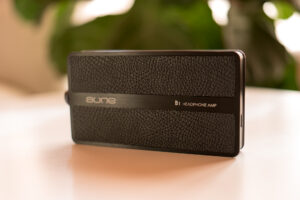 It’s a little bit tricky to make this comparison because the DIY is designed to have changeable op amps whereas the B1 is a discrete (no op amp) design. I decided to play around a bit to find a buffer / op amp combo in the DIY that sounded similar to the B1 in order to compare them less on sound signature and more on general qualities.
It’s a little bit tricky to make this comparison because the DIY is designed to have changeable op amps whereas the B1 is a discrete (no op amp) design. I decided to play around a bit to find a buffer / op amp combo in the DIY that sounded similar to the B1 in order to compare them less on sound signature and more on general qualities.
Honestly, once the signatures were matched, I would gladly choose either amp to drive my On1s, but keep in mind that the DIY is a special project that should have been worth significantly more than the B1’s ~$250 price. The B1 is standing toe-to-toe with a veritable giant at the price point we’re considering and I believe the B1 has a slightly better sense of texture and nuances compared to the DIY which means it’ll also outperform other portable amps like the standard E12, Cayin C5, and probably the E12A. I don’t have those other amps with me to try, but have extensively compared each one to the DIY and always found the DIY superior.
Both amps have sufficient grunt to also power the LCD 2s, but I once again found myself preferring the B1 thanks to its marvelous sense of realism and coherence – everything is just so well placed and balanced.
Overall Summary
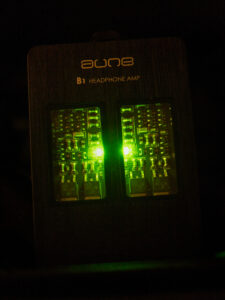 Moving through a range of headphones and trying different modes has really left me loving this little black beast with a glowing green heart. Its sound is, to my ears, neutral and accurate without tipping into becoming cold or analytical and it has a sense of energy and PRaT that’s beguiling. The fact that you can change operation modes to adjust its synergy with everything from portable on-ears to desktop-only planars makes it extra versatile and extra appealing. This is clearly the best portable headphone amplifier I’ve tried so far thanks to its great sound and versatility. It’s not the best portable amplifier in general terms because it’s really not compatible with IEMs and the E12DIY still owns the ‘generalist’ mantle for that reason (and the versatility of all those different buffers and op amps), but I flat-out love the Aune B1 and will be hard-pressed to see it go when the review period is up.
Moving through a range of headphones and trying different modes has really left me loving this little black beast with a glowing green heart. Its sound is, to my ears, neutral and accurate without tipping into becoming cold or analytical and it has a sense of energy and PRaT that’s beguiling. The fact that you can change operation modes to adjust its synergy with everything from portable on-ears to desktop-only planars makes it extra versatile and extra appealing. This is clearly the best portable headphone amplifier I’ve tried so far thanks to its great sound and versatility. It’s not the best portable amplifier in general terms because it’s really not compatible with IEMs and the E12DIY still owns the ‘generalist’ mantle for that reason (and the versatility of all those different buffers and op amps), but I flat-out love the Aune B1 and will be hard-pressed to see it go when the review period is up.
If you’re in the market for a portable amplifier for headphones, and you don’t mind something of a reasonable size and weight, you should absolutely do yourself a favour and check out the Aune B1. It looks good and sounds better!


